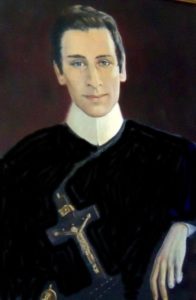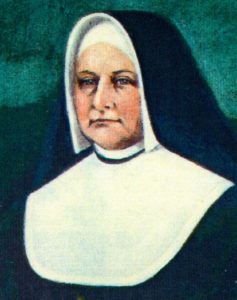Father Louis Florent Gillet

Louis Florent Gillet, born in Antwerp, Belgium, January 12, 1813, came from a family heritage that valued education, allowing him to receive the finest then available. His later academics included classical studies at the Royal College of Liege, religious education at the seminary in the ancient Abbey of Rolduc, and philosophy studies at the State University of Louvain. While such a roster could have led him to enter many fields at that time, the young Belgian decided to become a member of the Congregation of the Most Holy Redeemer (Redemptorists) in which he was ordained March 10, 1838.
Desiring to serve in ‘foreign missions,’ he joined his fellow Redemptorists in 1843 traveling to the newly formed parishes in pioneer territory in the United States. His dream, underscored by the New World’s mandate of Manifest Destiny, was realized as he eagerly departed for the missions in America. Once arrived in the United States, Father Gillet preached many successful missions, one of which was at St. Anthony in Monroe, Michigan. The parish was to become a missionary base for the Redemptorists and with its name changed to St. Mary of the Immaculate Conception, Father Gillet became pastor of the church. In 1844, Father Gillet met Theresa Maxis, a member of the Oblate Sisters of Providence in Baltimore and convinced her of the great needs of children along the prairie. In November 1845, she left the Oblate Sisters, and joining with Father Gillet, these two pioneers founded a community of vowed religious to meet those needs which they named the Sisters, Servants of the Immaculate Heart of Mary.
In 1845 Theresa Maxis became one of the first three members of the Sisters, Servants of the Immaculate Heart of Mary (IHM) in Monroe, Michigan (the other two were Sisters Ann Schaaf and Celestine Renauld). Born in Baltimore in 1810, of a Haitian mother and British father, she was well educated and articulate in both French and English. At age19, along with Mother Mary Lange and two other women, she became a founding member of the Oblate Sisters of Providence, the first congregation of women religious of color in the world.
While general superior of the Oblate Sisters, Theresa met Louis Florent Gillet, a Belgian Redemptorist seeking women religious to teach in Catholic schools in the still new state of Michigan. After much discernment, Theresa agreed to help Father Gillet found a new congregation in Monroe.
The congregation grew slowly but was well known for its educational works. A jurisdictional dispute about the congregation arose in 1859 between the bishops of Philadelphia and Detroit. Deeming Theresa responsible, the bishop of Detroit, deposed her as General Superior, and sent her to the Pennsylvania foundation, which later became a separate branch of the congregation.
Because of many difficulties and misunderstandings, Mother Theresa was forced to leave the Congregation and spent 17 years in exile with the Grey nuns of Ottawa, where she kept firm in her faith and love for her IHM Sisters. In 1885, Mother Theresa was allowed to return to the Immaculate Heart congregation in West Chester, Pennsylvania, where she lived her last seven years. Loved and admired by her sisters and others who knew her, Mother Theresa’s legacy of courage, peace and service to the poor continues in now the three IHM congregations of Monroe, Michigan, Immaculata and Scranton, Pennsylvania.
Mother Theresa Maxis Duchemin

In 1845 Theresa Maxis was one of the first three members of the Sisters, Servants of the Immaculate Heart of Mary (IHM) in Monroe, Michigan (the other two were Sisters Ann Schaaf and Celestine Renauld). Born in Baltimore in 1810, of a Haitian mother and British father, she was well-educated and articulate in both French and English. At age19, along with Mother Mary Lange and two other women, she became a founding member of the Oblate Sisters of Providence, the first congregation of women religious of color in the world.
While general superior of the Oblate Sisters, Theresa met the Redemptorist missioner, Louis Florent Gillet, who was seeking women religious to teach in Catholic schools in the still new state of Michigan. After much discernment, Theresa agreed to help Father Gillet found a new congregation in Monroe.
The congregation grew slowly but was well known for its educational works as well as charitable outreach. Theresa’s own mother joined the community but, when cholera struck Baltimore in 1831, the Oblates helped nurse the sick with Theresa’s mother who had recently joined the Sisters numbering among the fatalities.
A jurisdictional dispute about the congregation arose in 1859 between the bishops of Philadelphia and Detroit for which the bishop of Detroit held Theresa responsible. Deposing her as General Superior, he transferred her to the Pennsylvania foundation, which then became a separate branch of the congregation.
Because of these difficulties and other misunderstandings, Mother Theresa believed she might bring greater peace to all by joining another religious community. With this intention, she transferred to the Grey nuns of Ottawa and spent 16 years in exile with them while remaining firm in her faith and love for her IHM congregation. Having written to Mother Mary Gonzaga, IHM Mother General in West Chester, PA, Mother Theresa was invited to return to the IHMs at the West Chester motherhouse where she lived until 1892. Buried in the community cemetery at West Chester, her remains were transferred to the new grounds beside Camilla Hall Infirmary and Immaculata on August 2, 1965.
